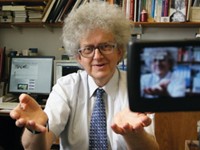Advertisement
Grab your lab coat. Let's get started
Welcome!
Welcome!
Create an account below to get 6 C&EN articles per month, receive newsletters and more - all free.
It seems this is your first time logging in online. Please enter the following information to continue.
As an ACS member you automatically get access to this site. All we need is few more details to create your reading experience.
Not you? Sign in with a different account.
Not you? Sign in with a different account.
ERROR 1
ERROR 1
ERROR 2
ERROR 2
ERROR 2
ERROR 2
ERROR 2
Password and Confirm password must match.
If you have an ACS member number, please enter it here so we can link this account to your membership. (optional)
ERROR 2
ACS values your privacy. By submitting your information, you are gaining access to C&EN and subscribing to our weekly newsletter. We use the information you provide to make your reading experience better, and we will never sell your data to third party members.
Education
Newscripts
Signed And Stamped
by Faith Hayden
January 25, 2010
| A version of this story appeared in
Volume 88, Issue 4

While trying to convey complex chemistry concepts to his students, high school chemistry teacher Jeffrey Hepburn likes to step back from the structures and inject a little humanity.
For example, when he's lecturing on Linus Pauling's electronegativity research, Hepburn takes a brief detour to discuss Pauling's life. "I try to convey to students that these are humans, and there's a human side to them," Hepburn explains. "I have one photo of Pauling being kissed on the cheek by two women. His signature is on that."
Hepburn has been collecting SIGNATURES from chemistry Nobel Laureates to use in his classroom since 1996, when he attended a National Science Teachers Association meeting. There, he ran into Glenn T. Seaborg, who was handing out periodic tables with his signature on them. "I thought it would be interesting to have these students touch something touched by a Nobel Laureate," Hepburn says.
He currently has autographs from more than 100 individuals—160 total on various pictures, cards, letters, or journals. Hepburn's favorite is a letter from Svante A. Arrhenius, who won the third Nobel Prize in Chemistry. "It's not in English, and with it I have a letter from the Berlitz School of Translation, which translated it for 50 cents in the early 1900s," he says.
Hepburn finds most of the mementos on eBay and through specialized autograph dealers, but a surprising number of items in his collection come from his direct solicitation of the laureates. "I draft a letter explaining that I'm a high school chemistry teacher and I would appreciate anything they can send, as well as any stories I can convey about them in the classroom," he says. Hepburn doesn't get many stories, and he doesn't always get a response, but he estimates that 30 to 40% of his collection comes this way.
Prices for the autographs can range from $10 to as high as $7,000 for someone like Marie Curie. "It's tough to find some of these," Hepburn says. Winners of the first 30 Nobel Prizes in Chemistry are especially challenging to uncover, "and a lot of them I don't have because of the cost and availability," he adds.
In addition to collecting signatures, Hepburn also amasses CHEMISTRY STAMPS from around the world. He currently has about 90 different stamps in his collection, including a 13-cent American Chemical Society stamp from 1976. "I have those in the thousands," he says. "I give them out to my students [when] congratulating them on taking the AP chemistry exam."
Hepburn joined the ranks of other chemistry-stamp-collecting enthusiasts (C&EN, Dec. 17, 2007, page 29) about 10 years ago while working on a grant to fund a program in which art and chemistry teachers would develop chemistry projects together. The stamps he has vary in content from Nobel Prize-winners to famous chemists to abstract chemistry concepts. Stamps are far less expensive than the autographs and can range from 20 to 40 cents apiece.
"There is some real beauty in chemistry stamps, and I try to convey that concept to my students," he says. "I have some students who might not be interested in chemistry but are interested in art, and it's a new way to connect them to the science."





Join the conversation
Contact the reporter
Submit a Letter to the Editor for publication
Engage with us on Twitter